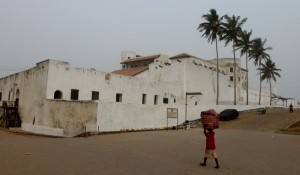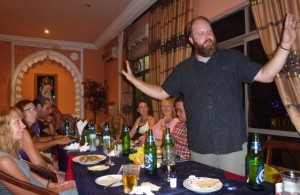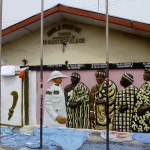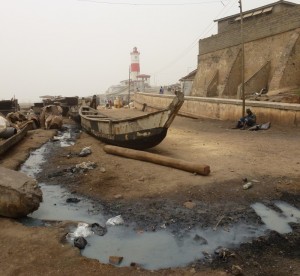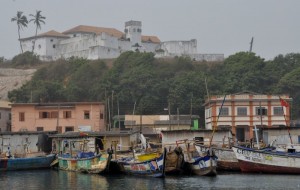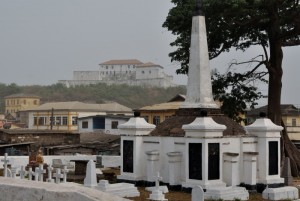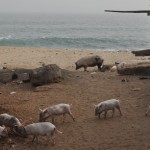Ghana, the first African country to gain independence in 1957, is seen as a relatively stable and successful nation in the continent. I had a leisure time in Ghana travelling from the southeast to Accra, along the coast to see the Cape Coast Castle and Elmina Castle (both World Heritage properties),then through central Ghana to reach northern Ghana before entering Mali. I had a pleasant stay in Akosombo, Elmina, Kumasi (former capital of Ashanti Empire) and the Mole National Park.
Background
Ghana with an area of 239,000 square kilometers and a population of 25 million is one of the most densely populated countries in Africa. It is predominated by the Akan (about 45% of the population); a group includes the Fanti and Ashanti. Other significant groups include the Nzema in the southwest, the Ga who are the indigenous people of Accra and Tema, the Ewe in the southern Volta region and the Dagomba around Tamale and Yendi and Gonja in the centre.
History
The present-day Ghana has been inhabited for over 6000 years. By the 13th century, several kingdoms had developed growing rich from the massive gold deposits in the area. By 16th century one of the kingdoms, the Ashanti, emerged as the dominant power controlling land even larger than Ghana today. Asantehenes, meaning rulers of the Ashanti people, began in the 16th century. The legend has it that a Golden Stool, symbol of Ashanti sovereignty floated from the heavens into the lap of Osei Tutu I marking the official formation of the Ashanti Kingdom and Osei Tutu I was crowned the Asantehene.
The Portuguese arrived on the coast in 1471 and built their fort at El Mina (“the mine”) in 1482. The British, French, Dutch, Swedes and Danes followed and each tried to establish their foothold and forts along the coast to facilitate their trading in gold, slave and other goods with the Ashanti. By late 18th century, the British had consolidated their control at the coast and had their eyes on the interior. There were four Anglo-Ashanti Wars in the 19th century i.e. 1823, 1863, 1869 and 1894. When war broke out between the Ashanti and the Fante in the 1870s, the British sacked the Ashanti capital,Kumasi in 1874. The Ashanti Confederation was made a British Protectorate in 1902 and the office of Asantehene was abolished while Prempeh I was exiled to Seychelles. But the title was revived in 1935 and the present Asantehene, Osei Tutu II took up the title since April 1999.
Calls for independence emerged in late 1920s. In 1948, Kwame Nkrumah, former secretary-general of the United Gold Coast Convention, formed a new party called the Conventional People’s Party (CPP) and became a popular leader. He called for a national strike in 1949 and was sent to jail. CPP won the elections in 1951 and Nkrumah was released to become the prime minister.
In March 1957, the Ashanti Protectorate, Northern Territories, Gold Coast Crown Colony and British Mandate of Togoland were united to form the modern state of Ghana and won its independence. Nkrumah became the first president of an independent African nation. He had problems with traditional chiefs and farmers and his interest in prestige projects including the Akosombo dam won him few friends. In 1966 while on a state visit to China, he was toppled in an army coup and died in exile in Guinea in 1972.
Ghana embroiled in corruption and debt problems was in political turmoil from 1966 to early 1990s with frequent change of governments and a couple of coups. In 1979, Jerry Rawlings, an air force pilot nicknamed ‘Junior Jesus’who led the Armed Forces Revolutionary Council (AFRC) against army affluence and military rule emerged as a rising star. After a coup, AFRC handed power to an elected civilian government with Hilla Limann as the president. The new government was unable to change the nation’s downward spiral and the president who was uneasy with Rawling’s popularity accused him of subverting constitutional rule. AFRC took over again in January 1982 and Rawlings remained in power for the next 20 years.
In 1992, Rawlings under pressure from home and abroad organized a referendum on a new constitution and finally lifted a 10-year ban on political parties. Rawlings won the 1992 and 1996 presidential elections and his National Democratic Congress (NPC) also won the parliamentary elections. John Kufuor won the 2000 and 2004 presidential elections and stepped down in 2009. John Atta Mills of the NPC,who won the elections, has been in power since then. By African standards, Ghana is hailed as one of Africa’s most stable and promising democracies.
Religion
Ghana is a deeply-religious country. About 70% of Ghanaians are Christian. About 15% of the population is Muslim; the majority is in the north. Many people retain traditional beliefs including ancestor veneration alongside Christian and Islamic beliefs.
Economy
The country is divided into ten administration regions. Its official GDP and GDP per capita was US$38.6 billion and US$3,100 (2011 est.) respectively. But the GDP (purchasing power parity) was estimated to be US$74.7 billion. Agriculture accounts for 40% of the domestic economy and Ghana is the world’s largest exporter of cocoa. Gold is also a major source of foreign exchange. Oil was discovered off the coast in 2007 and oil production began in December 2010.
Day 31 (Saturday, February 4): Mt Klouto – Kpalime, Togo – Akosombo, Ghana (255km; 5hrs)
The border crossing from Togo to Ghana was relatively easy. The Ghanaian immigration officers were polite and helpful. The road is surfaced with development all the way to Akosombo.
We arrived at our nice camp site right by the Volta River around 5pm. The town was built in early 1960s to house construction workers for building the hydro-electricity dam cross the Volta River.(The White Volta River and the Black Volta River combine to form the Volta River that eventually flows into the Atlantic Ocean). As a result, Lake Volta was created as the world’s largest artificial lake spreading over 3,275 square kilometres and running over 320 miles from the most northern point to the most southern point.
I had a nice swim on the river and had jollof rice (similar to Chinese fried rice) with chicken for dinner. My meal only cost me 9 cedis (1US$ for about 160 cedis).
Day 32: Akosombo
Ant drove us to see the dam and the power plant. We paid an entrance fee of 5 cedis and a lady took us on a guided tour explaining some 80,000 persons were resettled for this project. Ghana now sells electricity to Togo and Burkina Faso. Some 60% of Ghana’s electricity comes from hydro power. But I would say the scale of this project is modest when comparing to China’s colossal Three Gorges project.
I had street food for lunch. As I was hungry, I brought a piece of grass-cutter, mutton and fish for 9 cedis. Comparing with my dinner at the hotel, I think the food at the hotel is better and more value for money!
After lunch, I stopped at a supermarket for a cold drink. The owner, a 52- year old lady and mother of two kids, said she would be going to China for the second time this April to buy construction materials and other stuff to sell here. I note her shop is well-stocked with expensive wine and spirits and other quality food stuff. She looks smart and successful. I am glad to see a proud mother and a successful entrepreuer of a small business.
I was delighted to find free wifi at the hotel restaurant and spent the afternoon on the internet. The sky suddenly darkened. Dara and I immediately rushed to put a rain cover over our tent. Heavy torrential rains then poured down for over half an hour. I listened to the thundering sounds on the tin roof and was amazed when the sky cleared up and the ground became dry immediately after the rain.
There were two deciding football matches for the African Cup that day. The first one was between Mali and Gambon and the second one between Ghana and Tunisia. As expected, the second match was keenly watched by the Ghanaians. Each side only scored one in the first half. During the second half of the extra thirty minutes, the Ghanian team was lucky to strike a goal though in my view the Tunisians tried hard and played a better game. Ghana was one of the quarter-finalists and played against Mali (As we were at Fuller Falls on Day 39, we missed the game. In any case, Ghana lost to Mali and Zambia also beat Cote d’Ivoire to take the cup this year).
Day 33: Akosombo –Accra (190km; 3 hrs)
We had a smooth drive from Akosomo to Accra and we spent over two hours in the famous Accra Mall (a large shopping centre by local sandards). I found nothing interesting. Instead, I had a leisure lunch with three huge BBQ chicken wings and a cold beer with Jens who is most generous and helpful. As the road signs are not too good, Ant got lost and our truck was back to the Mall after an hour’s drive! He finally found the expressway to Accra and we got to Hotel Niagara around 4pm.
Accra, the capital of Ghana, is a sprawling city with a population of over 3 million. There are some beautiful tree-lined boulevards and the Dutch embassy is modern and sleek. As it was the last day for those who joined the 34-day trip from Doula to Accra, the group had a farewell dinner at the Lebanese diner at the hotel. Jens on behalf of the group presented a small token of appreciation to Mike and Ant. Jens is humorous and made a good speech in Viking style!
Day 34: Accra
At 10am, I joined a briefing for the second half of the trip from Accra to Dakar. We welcomed four new members (Mary, a Canadian, Berry, a Brit, Nicole and Christian, both German). Ant rushed out to get Mali visas for us.
While a few members went on a casket tour, I went on my own to see the oldest part of Accra at Jamestown and the fort which was a prison till 2008. The fishing village below the fort is a shantytown like Jamestown and Ussher Town. I also found a nice dress-maker who fixed two unfinished tops for me. I spent over an hour strolling around Jamestown, the lighthouse and Ussher Town looking at street food stalls and the market in the neighhourhood.
I then met Dorothy who runs a NGO providing free education for some 150 young kids in the area. These poor kids were crowded together and sat in front of a blackboard. The teachers just tried to keep them quiet. I do not know whether these kids learn anything useful. Dorothy was cooking sausages in tomato sauce but there was hardly enough food for 150 kids! Dorothy said she hoped to get land from the local council to build a bigger and proper school. I admire her efforts and wish her luck. I also made a small donation for her good work.
 I finally reached the famous Makola Market! I was struck by the heat and frenetic atmosphere where there are literally thousands of street peddlers and people trying to sell their commodities whether it is a new or used dresses or pants, kente cloth and batik, electrical goods, fruits etc. When I arrived at the old covered market, I met a nice young girl and brought a piece for cloth from her. But it was too late to get a tailor to do a suit for me. What a pity!
I finally reached the famous Makola Market! I was struck by the heat and frenetic atmosphere where there are literally thousands of street peddlers and people trying to sell their commodities whether it is a new or used dresses or pants, kente cloth and batik, electrical goods, fruits etc. When I arrived at the old covered market, I met a nice young girl and brought a piece for cloth from her. But it was too late to get a tailor to do a suit for me. What a pity!
I was exhausted after six hours’ walk in the unbearable heat and noises and was glad to be back to my hotel room at 5pm. Unfortunately, l have not managed to visit the National Museum which is supposed to feature excellent displays on various aspects of Ghanaian culture and history, the Independent Square with an Eternal Flame of African Liberation and see the Osu castle built by the Danes around 1659 which was once the seat of the government.
Peter took us to a nice restaurant nearby. I had a chance to talk with Mary, Berry and Christian and had an enormous dish of jollof rice!
Day 35: Accra – Cape Coast – Elmina (180km; 4 hrs)
After bidding farewell to Rick, Jens, Seona and Dara (my tent mate), we drove east to reach the famous Cape Coast. Ghana has a stunning coastal region stretching 550km from Cote d’Ivoire to Togo with remains of many colonial castles. The coast haunted by the ghosts of the past is one of the most culturally significant spots in Africa. Today, the Cape Coast Castle and the Elmina Castle stands majestically on the coast reminding the world of the inhuman and cruel slavery trade which was only abolished in the 19th century, the countless deaths, and suffering of the poor African slaves for centuries.
The whitewashed Cape Coast Castle is most picturesque with a commanding view of the coast. It was first built by the Dutch in 1637 and was expanded by the Swedes in 1652. It changed hands five times and was captured by the British in 1664. The present buildings were mainly built by the British who occupied it for two centuries. It was the headquarters for the colonial administration until Accra was made the new capital in 1877.
We had a good guided tour for an hour visiting the five halls for 1000 male slaves and the two halls for 400 female slaves where they were kept for two to three months before passing through the ‘Door of No Return’ when they were shipped off to the new world. I would definitely have gone mad if I had been shut up in the hall without toilet and shower facilities for several months with 199 other female slaves!
The museum has an informative display of the slave trade and many interesting exhibits. I spent over half an hour in the museum before making my way to the beach below to take a close look at this picturesque fishing village with the castle as the backdrop.
 |
 |
We went on to Elmina to see the St George’s Castle which was the oldest European building in sub-Saharan Africa. The castle built by the Portuguese in 1482 and captured by the Dutch in 1637, was served as the headquarters of the Dutch West Indies Company till it fell into the British hands in 1872. Same as the Cape Coast Castle, there are several halls where the 700 male and 300 female slaves were kept. The Portuguese church once converted into slave auctioning rooms is now a museum. The display is average. But I find the history, setting, architecture and atmosphere of this castle much more enchanting and interesting. Prempeh I was imprisoned in the castle for four years before his exile in the Seychelles.
We also visited the small Fort St Jago which stands on the hill top opposite the Elmina Castle. Elmina has a most colourful and lively fishing harbour with hundreds of wooden fishing boats of all sizes. As a result of the Harmatten wind, the sky was too hazy for good pictures.
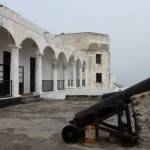 |
We stayed at the camp ground of Stumbling Inn at Brenu Akyinin, which has miles of beautiful sandy beach lined with coconut trees. We had a cooked meal from the restaurant for a change. The BBQ chicken and rice were excellent. I had a tent to myself as my tent mate Dara had left.
Day 36: Elmina
Dragoman supports a local grassroots charity, the Sabre Trust, which is working to improve education for children. We spent a morning in the school. For the first hour, I had a group of 8 children when I tried hard to capture their attention while teaching them something interesting and useful. Some of the kids aging between 6 and 9 do not yet recognize the 26 alphabets. I tried to teach them to count one to ten in English and then one to five in Chinese. But I did not think they could cope. Hence, I changed tactic and gave them paper and canyons to draw a butterfly, their house, a boat, a coconut and a banana tree and a fish i.e. something they are familiar with in their daily life. I hope they will remember the names in English and the spelling.
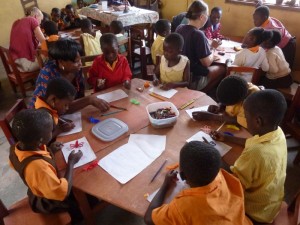 |
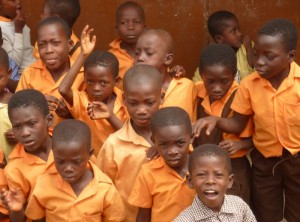 |
Then I was assigned the painting job where we painted the walls of one of the classrooms. Our group did an excellent job and the room looks fantastic, colourful and educational with alphabets, numbers, whales, dolphins, boats on the walls.
 |
 |
 |
 |
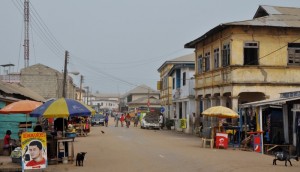 |
In the afternoon, I took a taxi to Elmina and visited the fish market. Then I walked to the Dutch cemetery and Cathedral and to see the old colonial buildings which are all run-down. But the whole place is charming, idyllic and atmospheric.
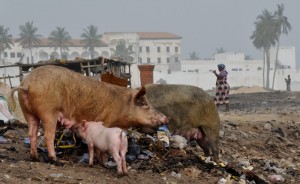 |
 |
I took the beach route to return to the camp site. To my horror, I find hundreds of shanty huts along the beach where numerous pigs are kept. They are fed on garbage. The beach is simply served as the toilet for both the locals and the pigs with urine and rubbish everywhere. The whole beach front is smelly, dirty and unhygienic.
I feel very sad and wonder why the local government can turn a blind eye to such development. The villagers should be taught to acquire proper personal hygiene practices and the pig farming should not be allowed along the beach/seafront unless there is proper sewage treatment. (See Part 2)


